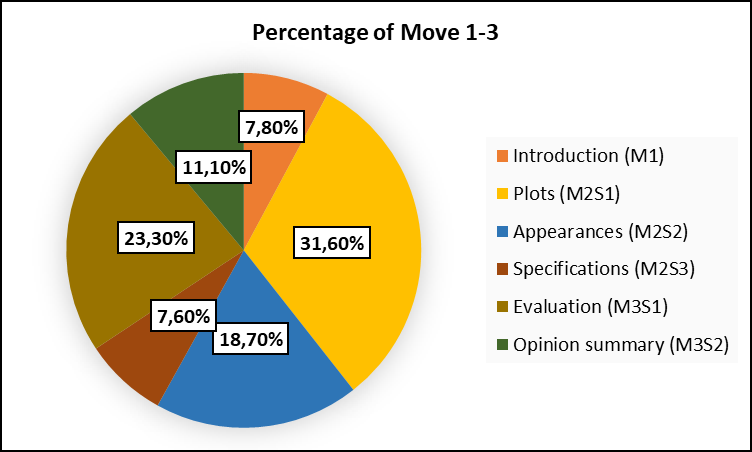Move analysis and critical thinking perception on third semester students’ review text
DOI:
https://doi.org/10.21070/jees.v7i2.1680Keywords:
genre analysis, move, review text critical thinkingAbstract
This study also examined third semester students’ critical thinking perception. The aims of this research are to found what are the move-step structure that lies in students' review texts and students’ critical thinking perception. Qualitative method is used as the approach. Totally 33 review texts are analyzed. The result revealed that there are 3 moves found. There are Move 1 in the introduction paragraph. Then Move to via Step 1, Step 2, and Step 3 that found in the interpretative recount. The last move is Move 3 via Step 1 which is found in the evaluation and Move 3 via Step 2 found in the evaluative summation. The result showed 434 moves found from 33 texts. The Move that mostly found were Move 2 via Step 1 which resumed what was the artwork/thing that being reviewed. This research also figured out the perception of critical thinking dealing with their review text writing products. Interview and questionnaire are used to unveil the critical thinking perception of the students. Most of the students still need guidance from their lecturer to develop their writing skills to be more precise.
HIGHLIGHTS:
- The kinds of genre analysis found in review text writing products from third-semester students of English Education in Universitas Muhammadiyah Semarang were Move. There were three moves found in the review text. The move consisted of obligatory and optional. The analysis also showed that some students still reversed in writing the content of the interpretative recount and the evaluation.
- The students understood the definition of the review text and the communicative purposes. They needed more facts to support their opinion or judgment in the review text. More specifically, the students still require coaching from their lecturer to strengthen their writing skills.
- The students’ perception of critical thinking in writing review text was still on an average scale, which meant they needed to force again their critical thinking to create better review text.
Downloads
References
Anamaryanti, Syarif, H., & Rozimela, Y. (2015). Students’ ability and problems in writing review text at grade XII SMAN 4 Kerinci. Komposisi: Jurnal Pendidikan Bahasa, Sastra, Dan Seni, 16, 1–16.
Creswell, J. W. (2012). Educational research : Planning, conducting, and evaluating quantitative and qualitative research (4th ed.). Pearson. https://doi.org/10.1163/9789087901219_007
Fathurahman, P. (2011). Metode penelitian pendidikan. Pustaka Setia.
Flick, U. W. E. (2009). An introduction to qualitative research. SAGE Publishing.
Gerot, L., & Wignell, P. (1994). Making Sense of Functional Grammar. AEE.
Guinto, N. L. (2012). Defying rhetorical orthodox: The Filipino youth and the structure of their narrative essays. 2012 Annual International Conference in Journalism and Mass Communication, April. https://doi.org/10.5176/2301-3729_jmcomm12.54
Haase, F.-A. (2010). Categories of critical thinking in information management. A study of critical thinking in decision making processes. Nómadas. Revista Crítica de Ciencias Sociales y Jurídicas, 27.
Martin, J. R. (1984). Language, register and genre. Children Writing: Reader, 1, 21–30.
Pho, P. D. (2009). An evaluation of three different approaches to the analysis of research article abstracts. Monash University Linguistics Papers, 6(2).
Rahmat, N. H., Aripin, N., Maizura Lin, N., Whanchit, W., & Khairuddin, Z. (2020). Exploring the connection between critical thinking skills and academic writing. International Journal of Asian Social Science, 10(2), 118–128. https://doi.org/10.18488/journal.1.2020.102.118.128
Sudarwati, S., & Grace, E. (2006). Look a Head, an English for Senior High School Students Year XII (SMA/MA). Erlangga.
Sugiyono, S. (2009). Metode penelitian kualitatif dan kuantitatif dan R&D. Alfabeta.
Swales, JM. (1981). Aspects of article introductions. Language Studies Unit, University of Aston.
Swales, John. (1990). Genre analysis: English in academic and research settings. Cambridge University Press. https://doi.org/10.2307/416471
Swales, John. (2004). Research genres: Explorations and applications. Cambridge University Press.
Uswar, Y., & Andriani, N. (2019). EFL students’ ability in writing reviews for a novel at a university in Medan. Studies in English Language and Education, 6(2), 300–308. https://doi.org/10.24815/siele.v6i2.14784

Published
How to Cite
Issue
Section
License
Copyright (c) 2022 Fairuz Nadhifah Izdihar, Testiana Deni Wijayatiningsih, Riana Eka Budiastuti

This work is licensed under a Creative Commons Attribution 4.0 International License.







